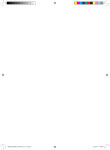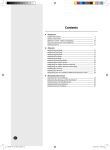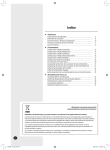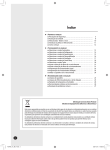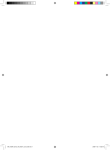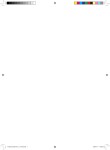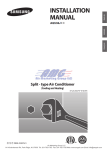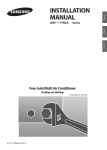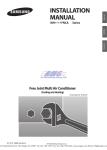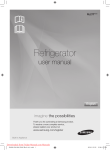Download Samsung AQV09F** Series Installation manual
Transcript
Contents PREPARING FOR INSTALLATION Safety Precautions . . . . . . . . . . . . . . . . . . . . . . . . . . . . . . . . . . . . . . . . . . . . . . . . . . 3 Choosing the Installation Location . . . . . . . . . . . . . . . . . . . . . . . . . . . . . . . . . . 5 Accessories . . . . . . . . . . . . . . . . . . . . . . . . . . . . . . . . . . . . . . . . . . . . . . . . . . . . . . . . . 6 INSTALLING THE AIR CONDITIONER Fixing the Installation Plate . . . . . . . . . . . . . . . . . . . . . . . . . . . . . . . . . . . . . . . . . 7 Purging the Indoor Unit . . . . . . . . . . . . . . . . . . . . . . . . . . . . . . . . . . . . . . . . . . . . 7 Installing and Connecting the Assembly Pipe of the Indoor Unit . . . . 8 Cutting or Extending the Pipe . . . . . . . . . . . . . . . . . . . . . . . . . . . . . . . . . . . . . . . 9 Installing and Connecting the Drain Hose of the Indoor Unit . . . . . . 10 Changing Direction of the Drain Hose . . . . . . . . . . . . . . . . . . . . . . . . . . . . . . 11 Installing and Connecting the Drain Hose of the Outdoor Unit . . . . . 11 Connecting the Assembly Cable . . . . . . . . . . . . . . . . . . . . . . . . . . . . . . . . . . . 12 COMPLETING THE INSTALLATION Purging the Connected Pipes . . . . . . . . . . . . . . . . . . . . . . . . . . . . . . . . . . . . . . . Performing the Gas Leak Tests . . . . . . . . . . . . . . . . . . . . . . . . . . . . . . . . . . . . . . Fixing the Indoor Unit in Place . . . . . . . . . . . . . . . . . . . . . . . . . . . . . . . . . . . . . . Fixing the Outdoor Unit in Place . . . . . . . . . . . . . . . . . . . . . . . . . . . . . . . . . . . . Final Check and Trial Operation . . . . . . . . . . . . . . . . . . . . . . . . . . . . . . . . . . . . . Providing Information for User . . . . . . . . . . . . . . . . . . . . . . . . . . . . . . . . . . . . . . 13 14 15 16 16 17 E-2 FORTE1_Inv_IM_E.indd 2 2007-2-16 14:08:18 ENGLISH Safety Precautions Keep this installation manual together with the user’s manual in a handy place so that you can find it whenever you need to see it after reading this manual thoroughly. Make sure to read the following safety precautions carefully before installation. Make sure to observe the cautions specified in this manual. Conduct a test run of the unit after installation and then explain all system functions to the owner. The indications and meanings are as shown below. WARNING This indicates the possibility of serious injury or death. Installation must be carried out by a qualified installer. Installers are required to read the general information carefully for safety. Do not put the unit near dangerous substances to prevent fire, explosion or injury and do not expose the unit to direct sunlight. Do not install the unit by yourself (owners). Incorrect installation of the unit could cause injury due to fire, electric shock and water leakage or from the unit falling. Consult a dealer or a qualified installer. Install the unit in a place where it is strong enough to hold the product weight. When installed in place where it is not strong enough to withhold the product weight, the unit could fall and cause injury. Use the specified wires to connect the indoor and outdoor units securely and attach the wires firmly to the terminal block connecting sections so that the pressure is not applied to the sections. Inappropriate connection and fixing could cause fire. Avoid the use of an extension cord and do not share the power outlet with other appliances. Incomplete connection, defective insulation or exceeding the permissible current may cause electric shock or fire. Make sure that the refrigerant gas does not leak after completing the installation. If the refrigerant gas of the indoor unit leaks and comes into contact with the fan heater, space heater or stove, harmful substances will be generated. Perform the installation securely referring to the installation manual. Incomplete installation could cause personal injury due to fire, electric shock and water leakage or from the unit falling. Attach the electrical cover to the indoor and outdoor unit securely. If not, it could result in fire or electric shock due to dust or water. Make sure to use the part provided or specified parts for the installation work. The use of defective parts could cause an injury or leakage of water due to a fire, an electric shock, the unit falling, etc. Make sure to turn off the main power when setting up the indoor unit electrical circuit or power cords. There is a risk of electric shock. E-3 FORTE1_Inv_IM_E.indd 3 2007-2-16 14:08:19 WARNING This indicates the possibility of serious injury or death. The unit should be installed in accordance with the National Electrical regulations. Ensure that the national safety code requirements have been followed for the main supply circuit. Ensure that a properly sized and connected ground wire is in place. CAUTION frequency of the main power supply are those required for the unit to be installed and check the connection. Make sure that properly sized disconnecting and safety switches are installed. Do not attempt to repair, move, modify or reinstall the unit on your own. Make sure that these installations are carried out by qualified personnel to avoid electric shock or fire. Use the unit on a single outlet circuit. Do not share the power outlet with other appliances. Obtain the consent by a qualified installer before connecting the unit to the power supply system. This indicates the possibility of serious injury or damage to environments when operated incorrectly. Check the unit for damage that may have taken place during transportation and do not install or use damaged equipment. All of the manufacturing and packaging material used for your new appliance are compatible with the environment and can be recycled. Dispose of the packaging material in accordance with the local requirements. This product is an air Check if the voltage and the conditioning system and contains a coolant that must be recovered and disposed of in an appropriate way by qualified personnel. At the end of the life cycle, take it to a proper recycling or disposal center or return it to the dealer so that it can be disposed correctly. Grounding the unit. Fasten a flare nut with a Do not install the unit in a To prevent injury when Do not connect the ground to a gas pipe, water pipe, lightning rod or telephone grounding. Defective grounding could cause electric shock. place where it is exposed to inflammable gas leakage. There is a risk of explosion. torque wrench as specified in this installation manual. When fastened too tight, a flare nut may break after a long period of time and cause refrigerant leakage. accidentally touching the indoor unit fan, install the indoor unit on a place higher than 2.5m. Install a ground leakage breaker depending on the installation place (where it is humid). If not, it may cause electric shock. Perform the drainage/piping work securely according to the installation manual. If not, water could drop from the unit and household goods could get wet and damaged. The air conditioner must be installed according to the national electrical regulations. The maximum input power & current is measured according to the IEC standard and the input power & current is measured according to the ISO standard. E-4 FORTE1_Inv_IM_E.indd 4 2007-2-16 14:08:19 PREPARING FOR INSTALLATION ENGLISH Choosing the Installation Location Indoor Unit Outdoor Unit Where airflow is not blocked Where cool air can be distributed throughout the room Install the refrigerant piping length and the height difference of both indoor and outdoor units as indicated in the installation diagram Wall that prevents vibration and is strong enough to hold the product weight Out of the direct sunlight 1m or more away from the TV or radio (to prevent the screen from being distorted or noise from being generated) As far away as possible from fluorescent and incandescent lights (so that the remote control can be operated well) A place where the air filter can be replaced easily Where it is not exposed to strong wind Well ventilated and dustless places Out of the direct sunlight and rain Where neighbors are not annoyed by operation sound or hot air Solid wall or support that prevents vibration and is strong enough to hold the product weight Where there is no risk of flammable gas leakage When installing the unit at a high place be sure to fix the unit legs 3m or more away from the TV or radio (to prevent the screen from being distorted or noise from being generated) Install the unit horizontally CAUTION Avoid the following places to prevent malfunction of the unit - Where there is machine oil - Where sulfide gas exists - Salty environment such as the seaside areas - Other special atmosphere areas Observe the clearances and maximum lengths as seen in the picture below when installing the air conditioner. 300 mm or more 125 mm or more Wrap the refrigerant pipes and the drain hose with the absorbent pad and vinyl tape. Refer to page 15 for further details. 125 mm or more You can select the direction of draining. (left or right) 7 meters maximum total pipe Height 600 mm minimum 15 meters maximum total pipe length 300 mm minimum 300 mm minimum 600 mm minimum The appearance of the unit may be different from the diagram depending on the model. E-5 FORTE1_Inv_IM_E.indd 5 2007-2-16 14:08:20 PREPARING FOR INSTALLATION Accessories The following accessories are supplied with the air conditioner: The number of each accessory is indicated in parentheses. Accessories in the Indoor Unit Case Installation Plate (1) Batteries for Remote Control (2) Remote Control (1) User’s Manual (1) Installation Manual (1) Drain Plug (1) Rubber Leg (4) Accessories in the Outdoor Unit Case 4-wire Assembly Cable (1) The flare nuts are attached to the end of each pipe of an evaporator or a service port. Use the nuts when connecting the pipes. The 4-wire assembly cable is optional. If it is not supplied, use the standard cable. The drain plug and rubber leg are only included when the air conditioner is supplied without the assembly pipe as seen in the picture below. The following connection accessories are optional. If they are not supplied, you should obtain them before installing the air conditioner. Assembly Pipe, Ø6.35mm (1) Assembly Pipe, Ø9.52mm (1) PE T3 Foam Tube Insulation (1) Vinyl Tape (2) Drain Plug (1) Rubber Leg (4) Pipe Clamps A (3) Pipe Clamps B (3) Cement Nail (6) M4 x 16 Tapped Screws (6) Drain Hose, length 2m (1) Putty 100g (1) If these accessories are supplied, they will be in the accessory box. E-6 FORTE1_Inv_IM_E.indd 6 2007-2-16 14:08:28 INSTALLING THE AIR CONDTIONER ENGLISH Fixing the Installation Plate Before fixing the installation plate to the wall or window frame, you must determine the position of the 65mm hole through which the cable, pipe and hose pass to connect the indoor unit to the outdoor unit. When facing the wall, the pipe and cable can be connected from the: Right Left Underside (right) Rear (right or left) If you fix the indoor unit to a... Follow step(s)... Wall 3. Window frame 4 to 6. 3 Fix the installation plate to the wall giving attention to the weight of the indoor unit. If you mount the plate to a concrete wall with anchor bolts, the anchor bolts must not project more than 20mm. 4 Determine the positions of the wooden uprights to be attached to the window frame. 5 Attach the wooden uprights to the window frame giving attention to the weight of the indoor unit. 6 Attach the installation plate to the wooden uprights using tapping screws as seen in the picture. (Unit : mm) Pipe hole (Ø65mm) 27 2 Determine the position of the pipe and drain hose hole as seen in the picture and drill the hole with an inner diameter of 65mm so that it slants slightly downwards. 27 1 120 68 Purging the Indoor Unit Upon delivery, there may be inert gas inside the indoor unit. Purge the gas from the indoor unit before connecting the assembly pipe. Unscrew the caps at the end of each pipe. Result: All inert gas exhausts from the indoor unit. To prevent dirt or foreign substances from getting into the pipes during installation, do NOT remove the caps completely until you are ready to connect the pipes. E-7 FORTE1_Inv_IM_E.indd 7 2007-2-16 14:08:35 INSTALLING THE AIR CONDTIONER Installing and Connecting the Assembly Pipe of the Indoor Unit There are 2 refrigerant pipes of different diameters: The smaller one is for the liquid refrigerant The larger one is for the gas refrigerant A short pipe is already fitted to the air conditioner. You may need to extend the pipe using the assembly pipe. (optional) A B C The connection procedure for the refrigerant pipe varies according to the exit position of the pipe when facing the wall: Right(A) Left(B) Underside(C) Rear 1 Cut out the appropriate knock-out piece on the rear of the indoor unit unless you connect the pipe directly from the rear. 2 Smooth the cut edges. 3 Remove the protection caps of the pipes and connect the assembly pipe to each pipe. Tighten the nuts first with your hands, and then with a torque wrench, applying the following torque: Outer Diameter 6.35 mm 9.52 mm 12.70 mm 15.88 mm 19.05 mm 22.23 mm Torque (kgf•cm) 140~170 250~280 380~420 440~480 990~1210 990~1210 If you want to shorten or extend pipes, refer to page 9. 4 Cut off the remaining foam insulation. 5 If necessary, bend the pipe to fit along the bottom of the indoor unit. Then pull it out through the appropriate hole. The pipe should not project from the rear of the indoor unit. The bending radius should be 100 mm or more. 6 Pass the pipe through the hole in the wall. 7 For further details on how to connect to the outdoor unit and purge the air, refer to page 13. The pipe will be insulated and fixed permanently into position after finishing the installation and the gas leak test; refer to page 14 for further details. E-8 FORTE1_Inv_IM_E.indd 8 2007-2-16 14:08:41 INSTALLING THE AIR CONDTIONER ENGLISH Cutting or Extending the Pipe A 5-meter pipe is supplied with the air conditioner. (optional) The length of the pipe can be: Extended up to 15 meters Shortened as required If you need a pipe longer than 5 meters: You must extend the assembly cable. You can install 15m of connecting pipe to the maximum, and you don't have to charge any additional refrigerant. 1 Make sure that you have the required tools (pipe cutter, reamer, flaring tool and pipe holder.) 2 If you want to shorten the pipe, cut it using a pipe cutter, ensuring that the cut edge remains at 90° with the side of the pipe (see examples of correctly and incorrectly cut edges below.) Oblique Rough Burr 3 To prevent a gas leak, remove all burrs at the cut edge of the pipe using a reamer. 4 Put a flare nut slightly into the pipe and modify the flare. Outer Diameter (D) 6.35 mm 9.52 mm 12.70 mm 15.88 mm 19.05 mm 22.23 mm 5 Damaged Surface Cracked Uneven Thickness Align the pipes to connect them easily. Tighten the flare nuts first with your hands, and then with a torque wrench, applying the following torque: Outer Diameter 6.35 mm 9.52 mm 12.70 mm 15.88 mm 19.05 mm 22.23 mm 7 1.3 mm 1.8 mm 2.0 mm 2.2 mm 2.2 mm 2.2 mm Check if you flared the pipe correctly (see examples of incorrectly flared pipes below.) Inclined 6 Depth (A) Torque (kgf•cm) 140~170 250~280 380~420 440~480 990~1210 990~1210 For further details on how to connect to the outdoor unit and purge the air, refer to page 13. FORTE1_Inv_IM_E.indd 9 E-9 2007-2-16 14:08:42 INSTALLING THE AIR CONDTIONER Installing and Connecting the Drain Hose of the Indoor Unit When installing the drain hose for the indoor unit, check if condensation draining is adequate. When passing the drain hose through the 65-mm hole drilled in the wall, check the following: 5cm less Ditch The hose must NOT slant upwards. The end of the drain hose must NOT be placed under water. Do NOT bend the hose in different directions. Keep a clearance of at least 5cm between the end of the hose and the ground. Do NOT place the end of the drain hose in a hollow. Drain hose installation: Shield Drain hose 1 If necessary, connect the 2-meter extension drain hose to the drain hose. 2 If you use the extension drain hose, insulate the inside of the extension drain hose with a shield. 3 Fit the drain hose into 1 of 2 drain hose holes, then fix the end of the drain hose tightly with a clamp. Extension drain hose If you don’t use the other drain hose hole, block it with a rubber stopper. 4 Pass the drain hose under the refrigerant pipe, keeping the drain hose tight. 5 Pass the drain hose through the hole in the wall. Check if it slants downwards as seen in the picture. The hose will be fixed permanently into position after finishing the installation and the gas leak test; refer to page 14 for further details. E-10 FORTE1_Inv_IM_E.indd 10 2007-2-16 14:08:43 INSTALLING THE AIR CONDTIONER ENGLISH Changing Direction of the Drain Hose You can select the direction of the drain hose, depending on where you want to install the indoor unit. 1 Detach the rubber cap with the flyer. Screws hole 2 Screw Detach the drain hose by pulling it and turning to the left. Drain hose 3 Insert the drain hose by fixing it into the groove of the drain hose and the outlet of the drain pan. 4 Attach the rubber cap with a screwdriver by turning it to the right until it fixes to the end of the groove. Drain pan outlet Rubber cap One of the diagrams has an illustration with the words “Screws hole” that should be changed to “Screw hole.” Installing and Connecting the Drain Hose of the Outdoor Unit While heating, ice may accumulate. During the process of defrosting, check if condensation draining is adequate. For adequate draining, do the following: 1 Insert the drain plug into the drain hole on the underside of the outdoor unit. There are 3 drain holes on the underside. You can use any hole for your convenience. Drain hole 2 Connect a drain hose to the drain plug. 3 Ensure that condensation draining is adequate. E-11 FORTE1_Inv_IM_E.indd 11 2007-2-16 14:08:44 INSTALLING THE AIR CONDTIONER Connecting the Assembly Cable The outdoor unit is powered from the indoor unit through the assembly cable. If the outdoor unit is more than 5 meters away from the indoor unit, you must extend the cable. The maximum length of the cable is 15 meters. N(1) 1 2 1 2 Indoor unit 1 Extend the assembly cable if necessary. 2 Open the front grille by pulling on the tabs on the lower right and left sides of the indoor unit. 3 Remove the screw securing the connector cover. 4 Pass the assembly cable through the rear of the indoor unit and connect the assembly cable to terminals as seen in the picture. Each wire is labeled with the corresponding terminal number. N(1) N1 N(1) 1 2 E E Outdoor unit N(1) 1 5 Pass the other end of the cable through the 65mm hole in the wall. 6 Close the connector cover, tightening the screw carefully. 7 Close the front grille. 8 Remove the terminal board cover on the side of the outdoor unit. 9 Connect the cables to the terminals as seen in the picture. 2 Screws on terminal block must not be unscrewed with the torque less than 12 kgf•cm. Each wire is labeled with the corresponding terminal number. 10 Connect the grounding conductor to the grounding terminals. 11 Close the terminal board cover, tightening the screw carefully. The designs and shape are subject to change according to the model. 12 Connect the power cable to the indoor unit. In Russia and Europe, consult with the supply authority to determine the supply system impedance before installation. Power cable specification Power cable Interconnection cable Power plug or circuit breaker 3G, 1.0mm2, 10A H05VV-F 4G, 1.5mm2 H07RN-F Power plug with earth pole. (More than 10A) Connect the power cable to the auxiliary circuit breaker. If every pole fails to connect to the power supply, it must be incorporated in a wire with a contact opening of ≥3mm. E-12 FORTE1_Inv_IM_E.indd 12 2007-2-16 14:08:47 COMPLETING THE INSTALLATION ENGLISH Purging the Connected Pipes The outdoor unit is loaded with sufficient R410A refrigerant for a 5-meter pipe You should purge the air in the indoor unit and in the pipe. If air remains in the refrigerant pipes, it affects the compressor. It may cause reduction of cooling capacity and malfunction. Refrigerant for air purging is not charged in the outdoor unit. Use Vacuum Pump as seen in the picture. 1 2 Connect each assembly pipe to the appropriate valve on the outdoor unit and tighten the flare nut. Tighten the flare nut first with your hands, and then with a torque wrench, applying the following torque: Outer Diameter 6.35 mm 9.52 mm 12.70 mm 15.88 mm 19.05 mm 22.23 mm Outdoor unit Indoor unit Gas pipe side Liquid pipe side Torque (kgf•cm) 140~170 250~280 380~420 440~480 990~1210 990~1210 3 Connect the charging hose of the low-pressure side of manifold gauge to a gas service port as seen in the picture. 4 Open the valve of the low pressure side of manifold gauge counterclockwise. 5 Purge the air in the connected pipes using the vacuum pump for about 10 minutes. - Close the valve of the low pressure side of manifold gauge clockwise. - Make sure that pressure gauge shows -0.1MPa(-76cmHg) after about 10 minutes. This procedure is very important to avoid a gas leak. - Turn off the vacuum pump. - Remove the hose of the low pressure side of manifold gauge. 6 Set a valve cork of liquid and gas service port to the open position. 7 Mount the valve stem nuts and the service port cap to the valve, and tighten them at the torque of 183kgf•cm with a torque wrench. Vacuum Pump Valve stem 8 Check for a gas leak paying particular attention to the 3-way valve’s stem nuts and to the service port cap. Stem cap A (gas) B (liquid) Adding Refrigerant You must add refrigerant if the pipe is longer than 5 meters. If you use a pipe... longer than 5 meters, shorter than 5 meters, Then... You can install 15m of connecting pipe to the maximum, and you don't have to charge any additional refrigerant. The purge time is normal. Refer to the Service Manual for further details. E-13 FORTE1_Inv_IM_E.indd 13 2007-2-16 14:08:48 COMPLETING THE INSTALLATION Performing the Gas Leak Tests C Make sure to check for gas leaks before completing the installation process (connecting the assembly pipe and hose between indoor unit and outdoor unit, insulating the cables, hose and pipe, and fixing the indoor unit to the installation plate) D To check for gas leaks on the... Using a leak detector, check the... Indoor unit Flare nuts at the end of sections C and D. Outdoor unit Valves on sections A and B. A B E-14 FORTE1_Inv_IM_E.indd 14 2007-2-16 14:08:48 COMPLETING THE INSTALLATION ENGLISH Fixing the Indoor Unit in Place After checking for gas leaks in the system, insulate the pipe, hose and cables. Then place the indoor unit on the installation plate. 1 To avoid condensation problems, place heat-resistant polyethylene foam separately around each refrigerant pipe in the lower part of the indoor unit. 2 Wrap the refrigerant pipe and the drain hose in the rear of the indoor unit with the absorbent pad. Wind the pipe and hose three times to the end of the indoor unit with the absorbent pad. (20mm interval) 3 Wind the pipe, assembly cable and drain hose with insulation tape. 4 Place the bundle (the pipe, assembly cable and drain hose) in the lower part of the indoor unit carefully so it doesn’t project from the rear of the indoor unit. Installation plate 5 Hook the indoor unit to the installation plate and move the unit to the right and left until it is securely in place. 6 Wrap the rest of the pipe with vinyl tape. 7 Attach the pipe to the wall using clamps (optional). E-15 FORTE1_Inv_IM_E.indd 15 2007-2-16 14:08:49 COMPLETING THE INSTALLATION Fixing the Outdoor Unit in Place Install the outdoor unit to a stable base to avoid the generation of noise and vibration, especially when installing the unit close to a neighbor. If you install the outdoor unit in a place exposed to strong winds or at a height, fix it to an appropriate support (wall or ground). 290mm 538mm Rubber leg 1 Place the outdoor unit as indicated on the top of the unit to let the discharged air out properly. 2 Fix the outdoor unit to an appropriate support using anchor bolts. 3 If the outdoor unit is exposed to strong winds, install shield plates around the outdoor unit so that the fan can operate correctly. Secure the rubber leg to prevent the generation of noise and vibration. Final Check and Trial Operation To complete the installation, perform the following checks and tests to ensure that the air conditioner operates correctly. 1 Check the following: Strength of the installation site Tightness of pipe connection to detect gas leak Electric wiring connection Heat-resistant insulation of the pipe Drainage Grounding conductor connection Correct operation (follow the steps below) 2 Press the button and check the following: The indicator on the indoor unit lights up. The airflow blade opens and the fan gears up for operation. 3 Press any button and check the following: The appropriate indicator lights up and the air conditioner operates according to the selected mode or function. 4 Press the button and check the following: The airflow blades work properly. E-16 FORTE1_Inv_IM_E.indd 16 2007-2-16 14:08:49 COMPLETING THE INSTALLATION ENGLISH Providing Information for User After finishing the installation of the air conditioner, explain the following to the user: (refer to appropriate pages in the User’s Manual.) 1 How to start and stop the air conditioner 2 How to select the modes and functions 3 How to adjust the temperature and fan speed 4 How to adjust the airflow direction 5 How to set the timers 6 How to clean and replace the filters When you complete the installation successfully, hand over the User’s Manual and this Installation Manual to the user for storage in a handy and safe place. E-17 FORTE1_Inv_IM_E.indd 17 2007-2-16 14:08:50 FORTE1_Inv_IM_E.indd 18 2007-2-16 14:08:51 ENGLISH INSTALLATION MANUAL Split - type Air Conditioner EΛΛHNIKA (Cooling and Heating) DEUTSCH PORTUGUÊS ITALIANO FRANÇAIS ESPAÑOL AQV09F Series AQV12F Series E S F I P D G DB98-27530A(1) FORTE1_Inv_IM_E.indd 19 2007-2-16 14:08:51


















